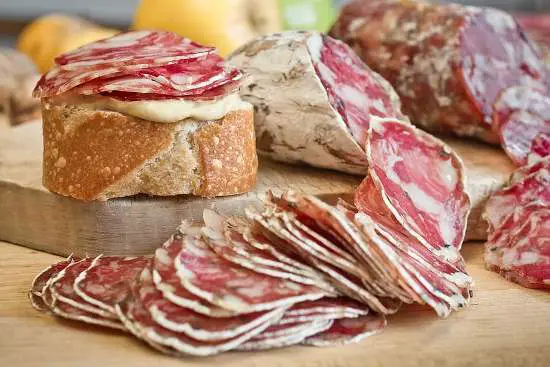Are you a lover of cured meats? If so, you’ve likely experienced both summer sausage and salami.
These two sausages share similarities in taste, appearance, and texture, posing a challenge in distinguishing between them. Nevertheless, there are distinctive characteristics that distinguish one from the other.
In this article, we’ll delve into the disparities between summer sausage vs salami, enabling you to pick your preferred option or differentiate between them.

Table of Contents
What is Summer Sausage?
Summer sausage boasts a captivating history, tracing its roots back to the arrival of German settlers in America who sought ways to preserve their food during extended journeys.
They devised summer sausage, a cured variety that remained palatable even in the sweltering summer months.
In contemporary America, any sausage capable of withstanding storage outside the refrigerator prior to opening is labeled as summer sausage.
This can encompass both dried and smoked sausages, with the key to their lasting freshness lying in the preservation techniques applied during the production process.
What is Summer Sausage Made Of?
The majority of summer sausages typically blend ground pork and beef, although beef-only variations are also available.
To impart the sausage with its tangy and flavorful profile, a medley of seasonings is incorporated. These may include black pepper, garlic, salt, mustard seeds, and other complementary ingredients.
What Is Summer Sausage Served With?
Summer sausage proves to be a versatile meat delicacy that harmonizes with various accompaniments, with wine and cheese emerging as the most favored pairings. Mild cheeses such as cheddar, Muenster, or Gouda complement the savory notes of summer sausage.
It’s equally delightful when paired with mild crackers, incorporated into sandwiches with a few slices, or utilized as a flavorful pizza topping.
For wine enthusiasts, excellent choices to accompany summer sausage include Chardonnay, Pinot Grigio, or Pinot Noir.
Summer Sausage Shelf Life: How to Store It

A crucial consideration revolves around whether to store your summer sausage in the refrigerator or the pantry.
Typically, commercially available summer sausages, fortified with preservatives and chemicals, can be stored at room temperature. However, it’s advisable to scrutinize the label, as some varieties may necessitate refrigeration.
If the label indicates “Refrigerate after opening,” it should not be stored in the pantry.
When crafting your homemade summer sausage, optimal preservation involves refrigeration and sealing it in an airtight container, extending its shelf life to approximately three weeks.
For an even lengthier preservation period, investing in a food-grade vacuum sealer is a wise choice. Crafting and vacuum sealing your summer sausage, then storing it in the fridge, can potentially prolong its freshness for up to three months.
Notably, unlike dried meats like salami, summer sausage retains moisture post-cooking, contributing to a reduced shelf life.
> Read more: Summer sausage vs Trail Bologna
What is Salami?
Salami is a variety of cured meat that undergoes seasoning, fermentation, and subsequent drying to attain its unique flavor and texture.
The typical salami-making process involves combining meat, fat, cure, and seasonings, then stuffing the resulting mixture into a specialized casing. Traditional seasonings encompass garlic, salt, and a blend of herbs, although various recipes may incorporate additional seasonings for distinctive flavor profiles.
What Types of Meat are Used to Make Salami?
While pork remains the conventional choice for crafting salami, a diverse array of meat options is now accessible. Beef, turkey, and wild game are just a few examples of meats suitable for salami production.
When selecting the meat, it’s crucial to take the fat content into account, as fat plays a significant role in shaping the flavor and texture of the salami.
How is Salami Made?

The salami-making process entails combining meat, fat, cure, and seasoning before stuffing the mixture into a specialized casing. Subsequently, the salami undergoes a period of fermentation and drying, a duration that varies from a few days to several years, depending on the chosen production method.
Throughout the fermentation stage, the levels of yeast and lactic acid in the sausage elevate, imparting the distinctive flavor that characterizes salami.
What are the Different Types of Salami?
The global popularity of salami has given rise to a multitude of distinct types. Some of the most well-received varieties include:
- Nduja: A pork sausage salami featuring a spicy kick from chili.
- Salame Napoli: Crafted from pork loin, leg, shoulder, and specific spices.
- Genoa: A salami seasoned with garlic and red wine.
- Milano: Similar to Genoa but with a milder flavor.
- Soppressata: Hailing from southern Italy, this salami is seasoned with hot pepper.
- Beyond these, numerous regional variations of salami exist, with special types originating from Italy, Germany, Spain, and France.
How Should Salami be Served?
Salami offers a versatile range of enjoyment, such as:
- Sliced as a snack or appetizer.
- Topped on pizza or in pasta dishes.
- Fried up with eggs or used in a sandwich.
- Featured on a charcuterie board alongside cheese, crackers, and other meats.
What is the Shelf Life of Salami?
Unopened salami has a shelf life of up to 6 weeks when stored in the pantry. Once opened, it is recommended to consume it within 1 week.
Nevertheless, it’s crucial to note that various types of salami might have distinct expiration dates. Therefore, it’s imperative to consistently check the packaging and adhere to the provided storage guidelines to prevent spoilage.
Also read: ‘Why does my salami have black spots?’ by clicking here.
What Makes Summer Sausage Different From Salami?
We will explore the key difference between salami and summer sausage, helping you discern which is better suited for your next charcuterie board.
Moisture Content: The Main Differentiator
The primary contrast between summer sausage and salami lies in their moisture content. Summer sausage qualifies as a semi-dry sausage, retaining more moisture than salami.
Throughout production, summer sausage typically loses around 15% of its original weight. In contrast, salami undergoes a more extensive drying process, resulting in a loss of up to 25% of its moisture content, rendering it a dry sausage.
Shelf Life: An Important Factor to Consider
Both salami and summer sausage, being cured meats, boast longer shelf lives than uncured counterparts. However, differences exist in their respective shelf lives.
The United States Department of Agriculture (USDA) advises refrigerating summer sausage for a maximum of three months, with an opened package lasting up to three weeks.
Conversely, unopened salami can remain at room temperature for up to six weeks, and once opened, it stays fresh for three weeks in the refrigerator.
Texture: Slicing Difficulty and Enjoyment
Another notable divergence between summer sausage and salami is their texture.
Due to variations in moisture content, summer sausage exhibits a softer texture and is easier to slice than the firmer-textured salami.
The softer texture of summer sausage makes it an excellent addition to sandwiches, while salami’s firmer texture positions it as an ideal choice for charcuterie boards and antipasti platters.
Curing and Seasoning: Different Styles
The curing and seasoning process contributes to the differentiation between salami and summer sausage. While both generally undergo curing using sodium nitrite or sodium nitrate, their seasoning and curing methods can vary.
Summer sausage is typically seasoned with black pepper and garlic, resulting in a milder flavor profile. In contrast, salami is crafted with a blend of spices, including paprika, garlic, and fennel, yielding a more robust and spicier taste.
Conclusion
Both salami vs summer sausage stand out as delectable cured meat choices, yet they present noteworthy distinctions.
Summer sausage, being a semi-dry variety, boasts a softer texture, whereas salami, categorized as a dry sausage, offers a firmer texture.
In terms of flavor, summer sausage leans towards a milder profile, while salami delivers a more robust and spicier taste.
Ultimately, the decision between the two hinges on personal preference and the intended culinary application.
Difference between the two
Main difference, harder to slice than summer, salami contains, what’s the difference, salami vs, type of sausage, ferment, fermentation process, ground meat, meat is ground, tangy taste, growth of bacteria, made with pork, stuffed into a casing, ready to eat, dried or smoked.

Fernando is the creator and writer behind the food blog Eating with your Hands. Living and working in cities like Paris, Barcelona, and Berlin, and being married to a Canadian foodie, has given Fernando a passion and interest in food and inspired him to run EWYH.
